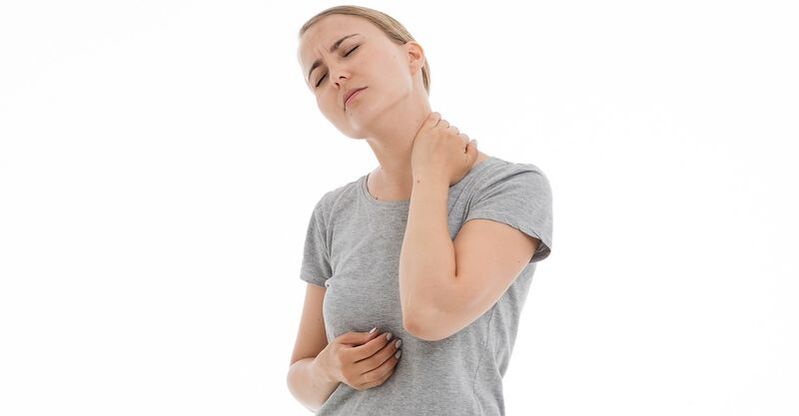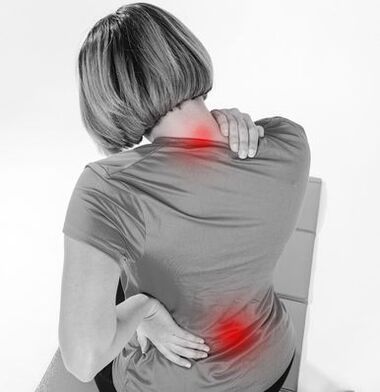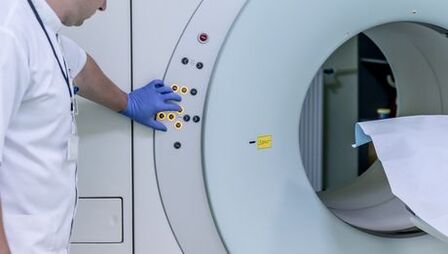
Do you feel back pain and limb numbness?These are the first signs of osteochondrosis.Inadequate lifestyle mobility, sitting work, neck and spine load leads to the fact that cartilage wears out and loses moisture, which is a result of which they are damaged.
With cervical osteochondrosis, degenerative changes in the intervertebral discs occur.Not only the discs are subjected to damage, but also the vertebrae and joints in the cervical region.If you do not cure the disease for a long time, the patient's overall health worsens: constant headache, the appearance of vertebrates, worsening of cerebral circulation, resulting in cognitive functions decreased.
The causes of the development of osteochondrosis
Improperly sitting position in which the neck extends forward leads to the development of cervical disease.In this case, excessive pressure occurs on the intervertebral discs, which leads to changes in the nuclear pulp and the pressure of the blood vessels.This position is a person at work in front of the computer.Therefore, office workers are most often subjected to the development of osteochondrosis of the cervical spine.

In addition, the causes of the development of the pathology can be:
- Improper distribution of bags when carrying bags;
- Too soft sleeping place (the spine is a bending in unnatural form);
- genetic predisposition;
- lack of vitamins and monitors in the diet;
- endocrine systems disorders;
- spinal curvature and a disorder of the posture during active body growth;
- injuries to the cervical vertebrae;
- Having bad habits.
Stages of the disease
To determine whether the symptoms of pain are signs of the development of osteochondrosis of the cervical spine and what stage in the development of the disease can only be determined by an experienced doctor after examination and palpation.Total, cervical osteochondrosis passes four stages of development:
- Nuclear Pulpos - The central part of the intervertebral disc in the first stage is subjected to moderate dehydration.As a result, the supporting and associate functions of the intervertebral discs are gradually lost.In the first stage you will experience pain with sudden movements, hypothermia and stay in one post for a long time.
- The second stage of development is characterized by the appearance of stagnant phenomena and cramps, which squeeze the capillaries and blood vessels, preventing normal circulation.As a result, the frame of the intervertebral disc is sharper, forming prosfrusion (protruding forward or back).Under the influence of excess load on the cervical vertebrae, osteophytes are formed.The sensations of pain are localized in one place, with sharp turns and slopes of the head, there may be dislocations of the cervical vertebrae.
- The extrusion is formed as a result of thinning of the intervertebral discs.The edge of the pulpulated nucleus breaks the fibrous ring and exceeds the ends of the vertebrae body.Muscles and nerve endings are pressed.It is felt by pain in the neck, back and limbs.
- In the fourth stage of the disease, the intervertebral discs are shifted and formed by central and lateral hernias.In addition, scars are formed on the discs, leading to the immobility of the affected joint.The patient experiences constant back pain, which is given to other parts of the body, a constant feeling of fatigue occurs, asymmetry of parts of the trunk occurs.

Symptoms of cervical osteochondrosis
Symptoms of osteochondrosis of the cervical spine occur differently depending on the stage of development of the pathology.In the early stages, this can appear practically without the presence of signs.Neck and back pain can only occur in case of prolonged stay in one posture, acute inclination or rotation.
At the short stages of development, a crunch in the spine is heard, the pain in the back is transmitted to other limbs, there is a tingling of parts of the body.With the formation of osteophytes and extrusion, there are:
- headache in the back of the head and parietal part;
- disturbed speech and tingling of the tongue;
- Reducing the sensitivity of the neck of the neck;
- respiratory disorders;
- I swear on blood pressure;
- heart rate disorders;
- noise and stagnation in the ears;
- Seizure.
Symptoms of osteochondrosis of the cervical spine in women are much more pronounced than in men.This is due to the fact that women have a predisposition to vascular diseases and a more fragile structure of the bone segments of the spine.The signs of the disease begin to occur when the intervertebral discs appear.This leads to disruption of normal blood circulation and causes severe headache, dizziness and neurosis.During menopause, there is often an exacerbation of the disease in women when the body is subject to changes in hormonal origin.
The symptoms of cervical osteochondrosis in men are similar to female, erectile dysfunction can be observed separately.
The headache for cervical osteochondrosis is caused by blood circulation in the brain and spinal cord.When the vertebrae are shifted, they squeeze the arteries and the oxygen content of the blood decreases.Unfortunately, such pain may not pass even after taking strong painkillers.Therefore, it is important to approach the problem exhaustively.Dizziness of cervical osteochondrosis can be accompanied by darkening in the eyes, the appearance of noise in the ears.This happens because the spasored muscles cause a decrease in oxygen access to the brain.
A lump in the throat with osteochondrosis of the cervical spine, as well as burning, difficulty breathing and muscle cramps - this is a common occurrence.The disease causes the nerve fibers of the cervical spine to the head and neck.Nerve impulse disorders cause sore throat.
Due to the spasms of the blood vessels and the irritation of the nerve endings, jumps in blood pressure appear.Increased lower osteochondrosis pressure indicates that the blood supply to the individual areas of the brain is impaired as the spinal artery survived the intervertebral discs.As a result, oxygen starvation occurs and blood pressure increases.

How is the diagnosis of osteochondrosis of cervical spinal osteochondrosis?
The diagnosis of pathology begins with specialized consultation.In the first manifestations of osteochondrosis, contact the rheumatologist, neuropathologist, surgeon or traumatologist-orthodist.The doctor will ask about the symptoms and frequency of their manifestation, it is necessary to provide the specialist with the full history of the disease and the results of the early studies (if any).The specialist will perform a visual inspection and palpation, direct it to tests.During the examination, the doctor pays special attention to the mobility of the neck, muscle tone, skin sensitivity and reveals the most painful areas.
In order to identify the condition of the muscles, ligaments, blood vessels, to detect inflammatory processes or tumors, an information and safe diagnostic method is prescribed - NMR of the cervical spine.The patient during MRI osteochondrosis is located on a special retractable table with the back.The roles are placed on the head to the patient to remove the muscle tension and the limbs are fixed with belts.Any minor movement during the procedure can affect the quality of the result.Then the table stops in the tomograph.The procedure does not cause pain.The tomograph makes a heavy noise during scanning so you can use the headset to avoid discomfort.
If the MRI is contraindicated, there are other diagnostic methods such as computed tomography and radiography.X -ray is only suitable for the primary diagnosis and does not give a layer -in -layer image of the affected tissues.However, this study is the simplest and most economical one that allows you to examine the patient's body in several projections.Due to the high radiation load on the body, radiography cannot be performed often.
During computed tomography, scanning is done using one or more bundles of ionizing rays.They pass through the human body and are recorded by detectors.The detectors move on the patient's body in opposite directions and are fixed up to 6 million signals.The image shows a different density of the tissues with the precise determination of the boundaries of the organs and the affected areas in the form of a section.The procedure allows you to get a layer image.

Treatment of osteochondrosis of the cervical spine
How to treat osteochondrosis of the uterus, only a doctor will determine after examination, studying medical history and receive the results of hardware diagnostics.If the disease is diagnosed at an early stage, then treatment will undergo conservative ways.In the treatment of osteochondrosis, it is important to stick to an integrated approach - to take medication, to participate in physiotherapy, to go to therapeutic massage and to avoid heavy exercise.
First of all, you have to stop the pain.This is prescribed analgesics and painkillers.With strong muscle cramps, they are prescribed to wear an orthopedic collar.Once the pain syndrome has been eliminated, it is necessary to stop the inflammatory process and to restore normal circulation.An antioxidant, anti -inflammatory therapy, is performed for this.Additional measures are prescribed therapeutic exercises, swimming.You can participate in physical education both at home and with a coach.
If osteochondrosis has become severe, the doctor may prescribe surgery.The surgery resorts to rare cases where the pathology develops against the background of other diseases - scoliosis, hernia of intervertebral discs, curvature or displacement of the spine, injuries.
The treatment of cervical osteochondrosis in women is not particularly different from the treatment of men.However, doctors often recommend that women make external compresses to warm and strengthen the muscles of the neck.
Experts recommend that you prevent various back diseases from early childhood.To do this, you must form the right stand while walking and staying on the desktop.Full nutrition and proper strengthening of the back muscles will help to avoid negative effects in the future.



































